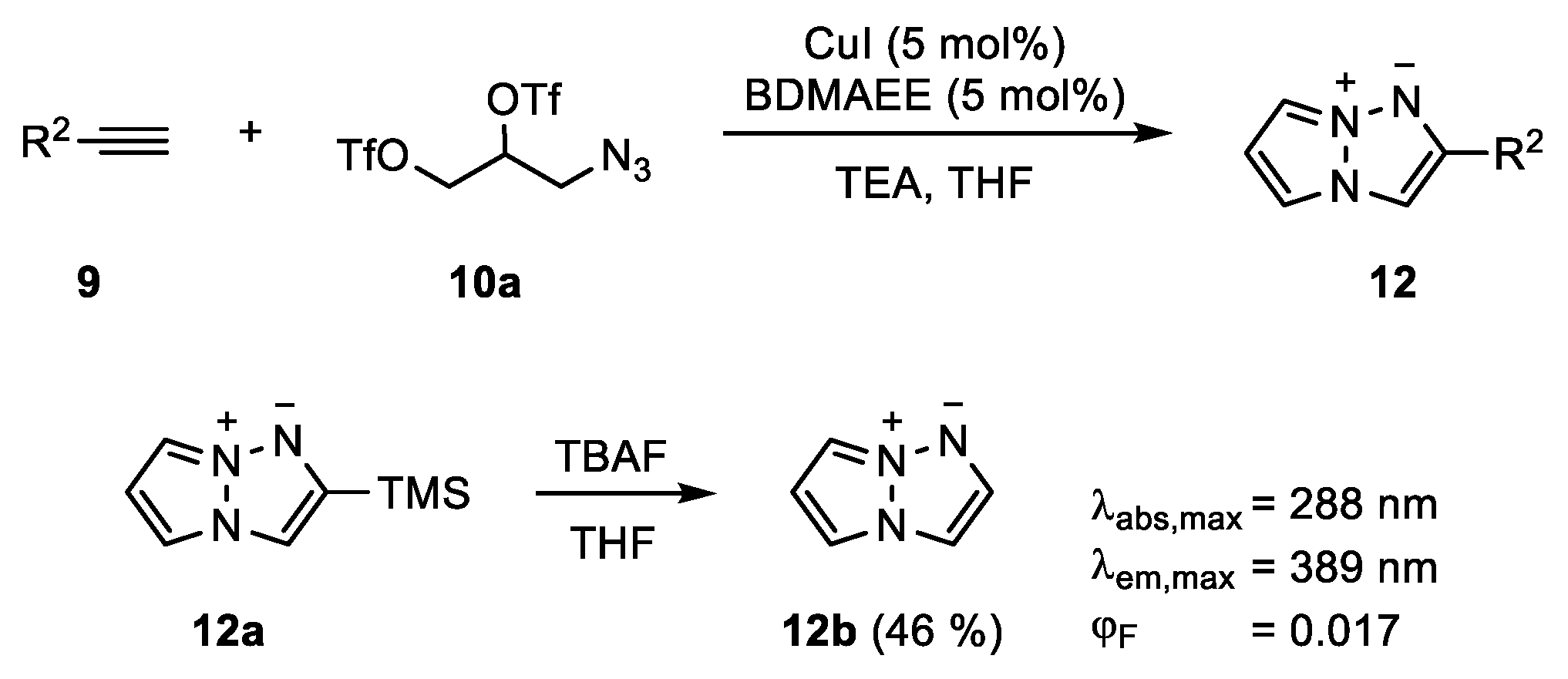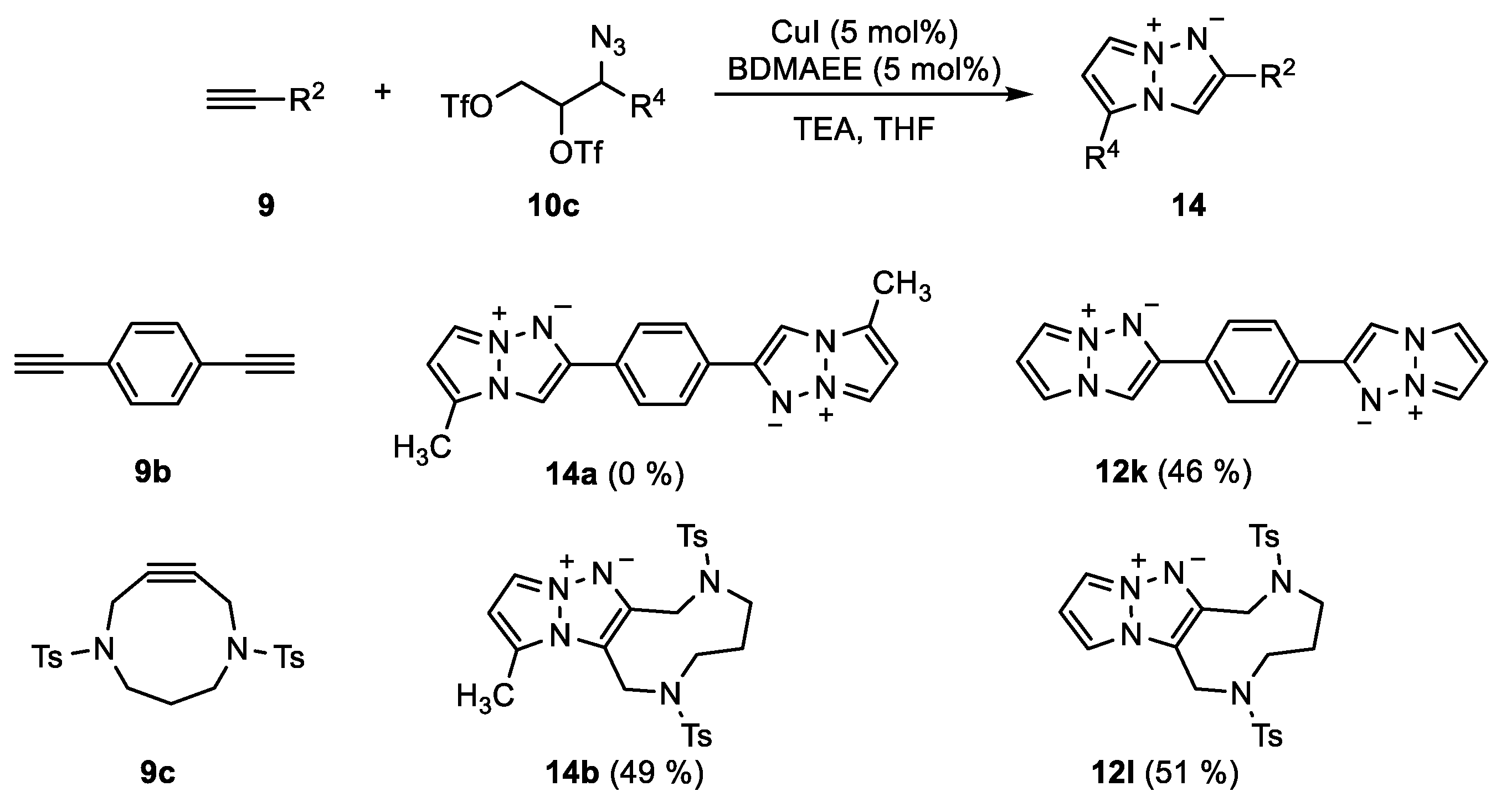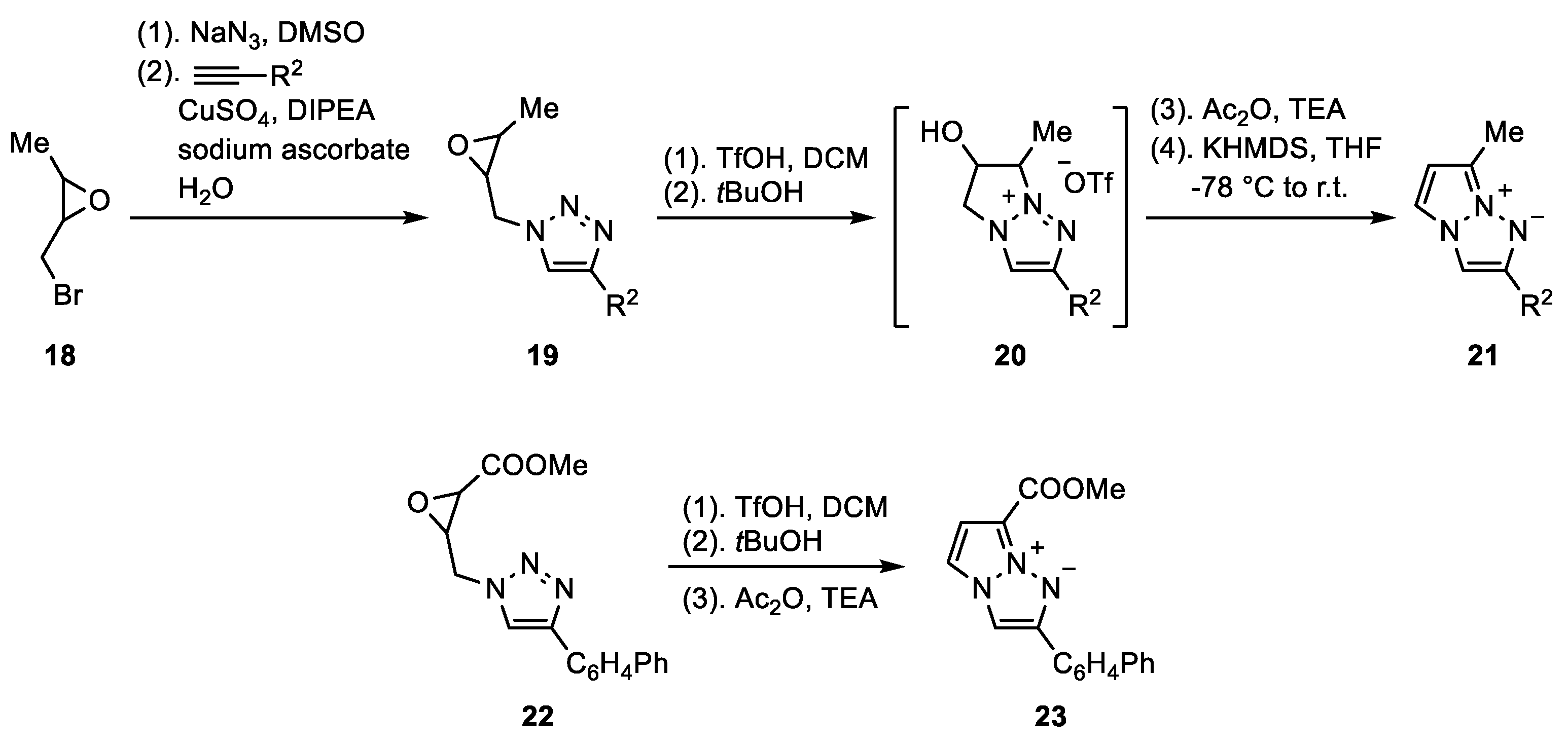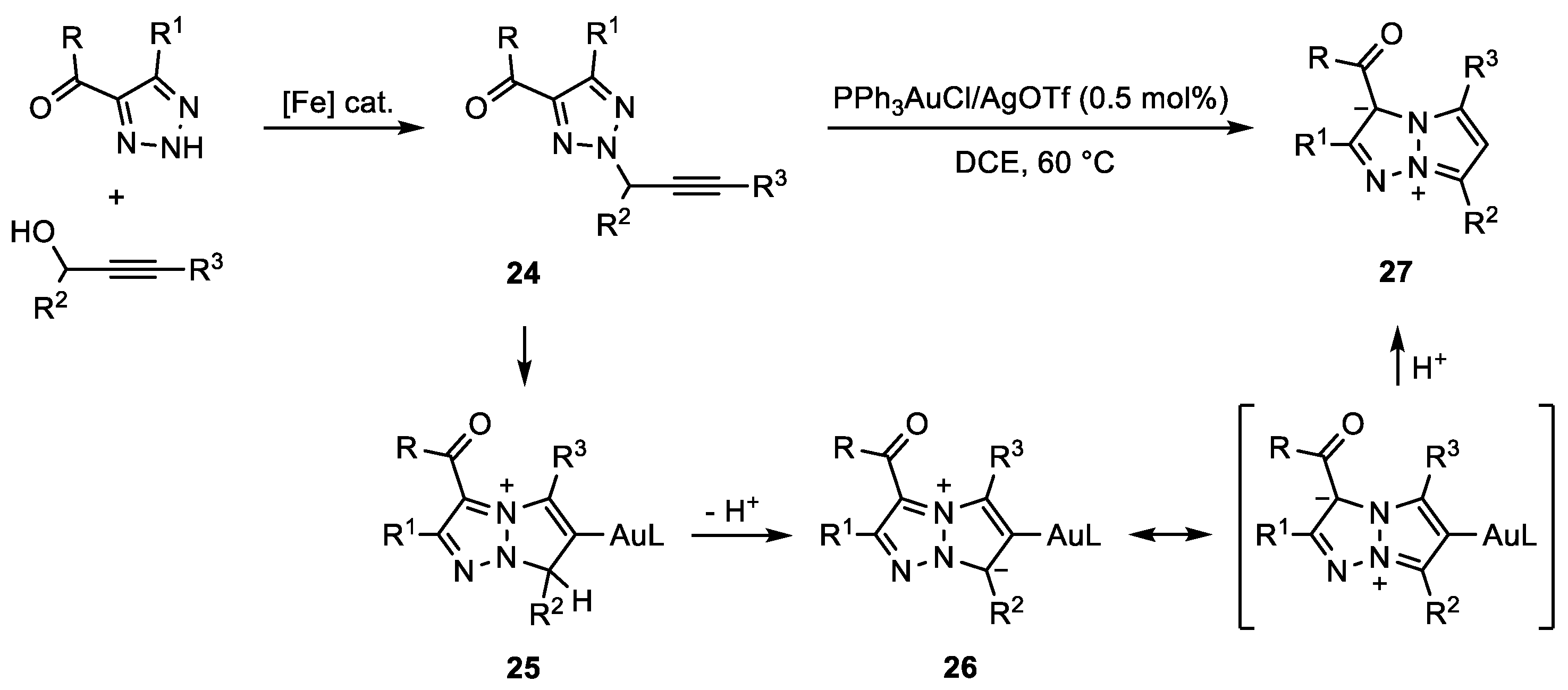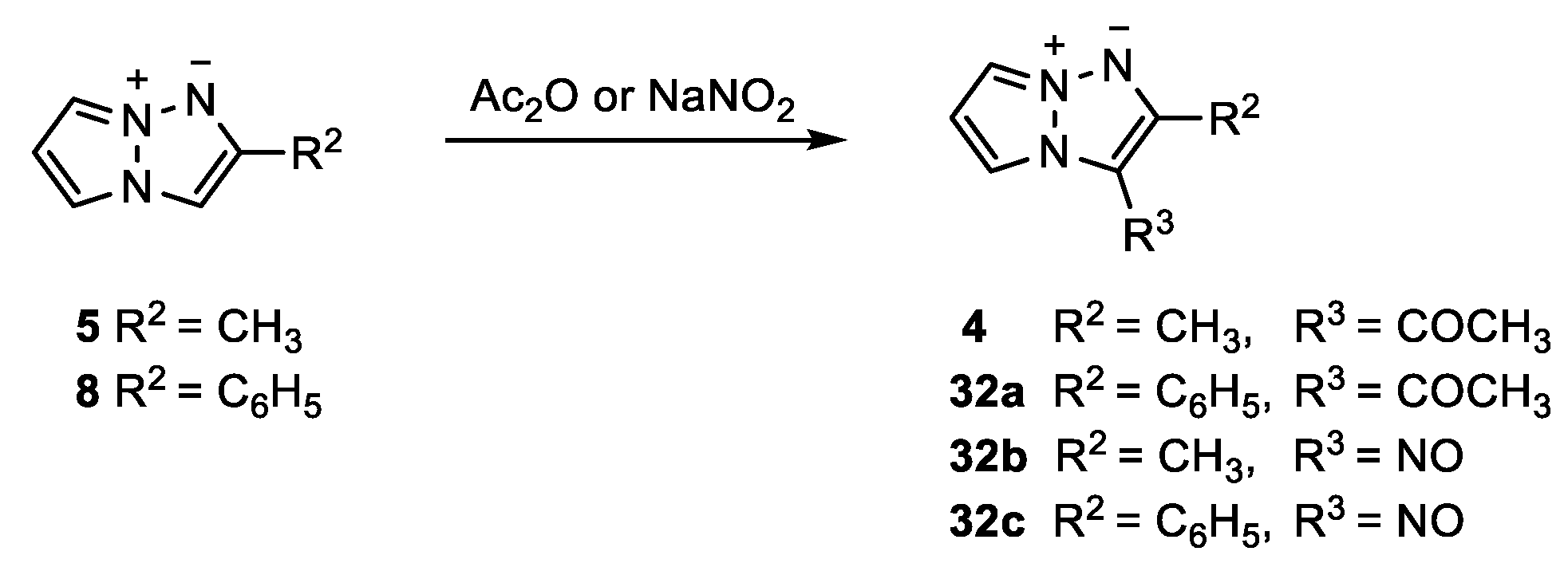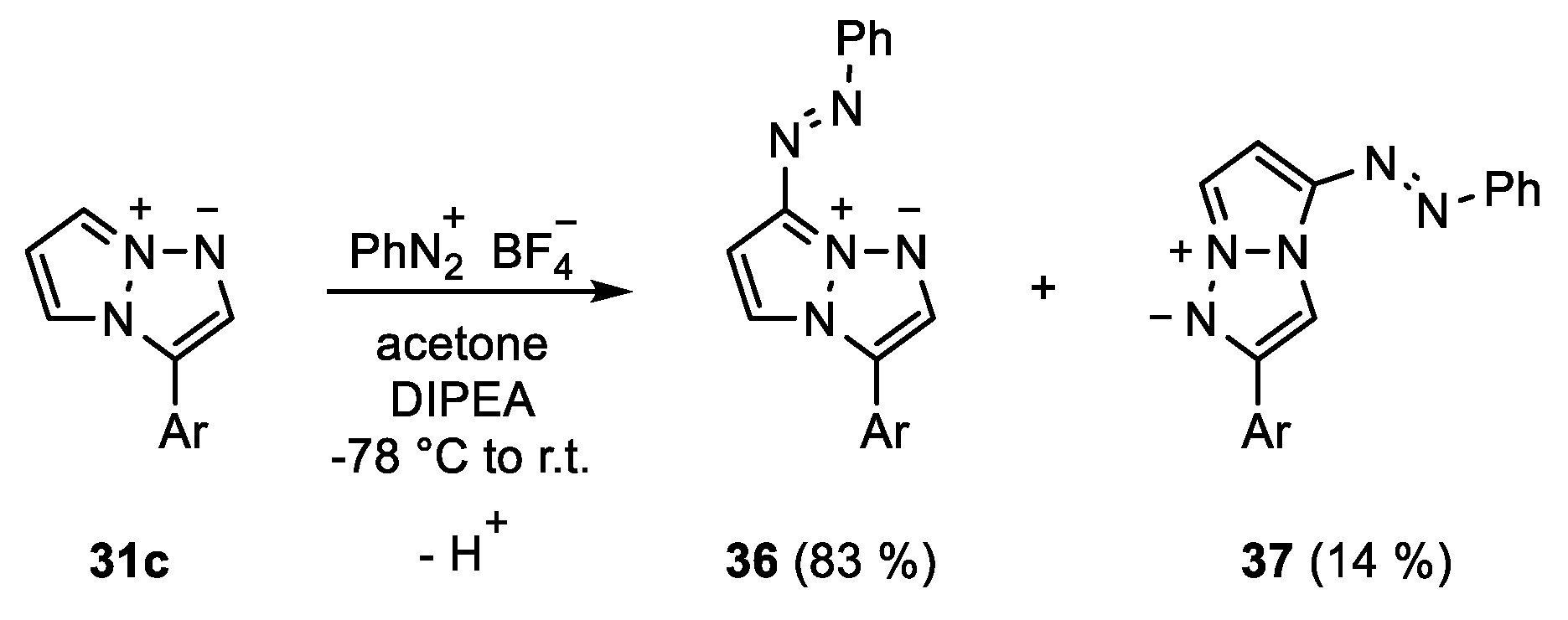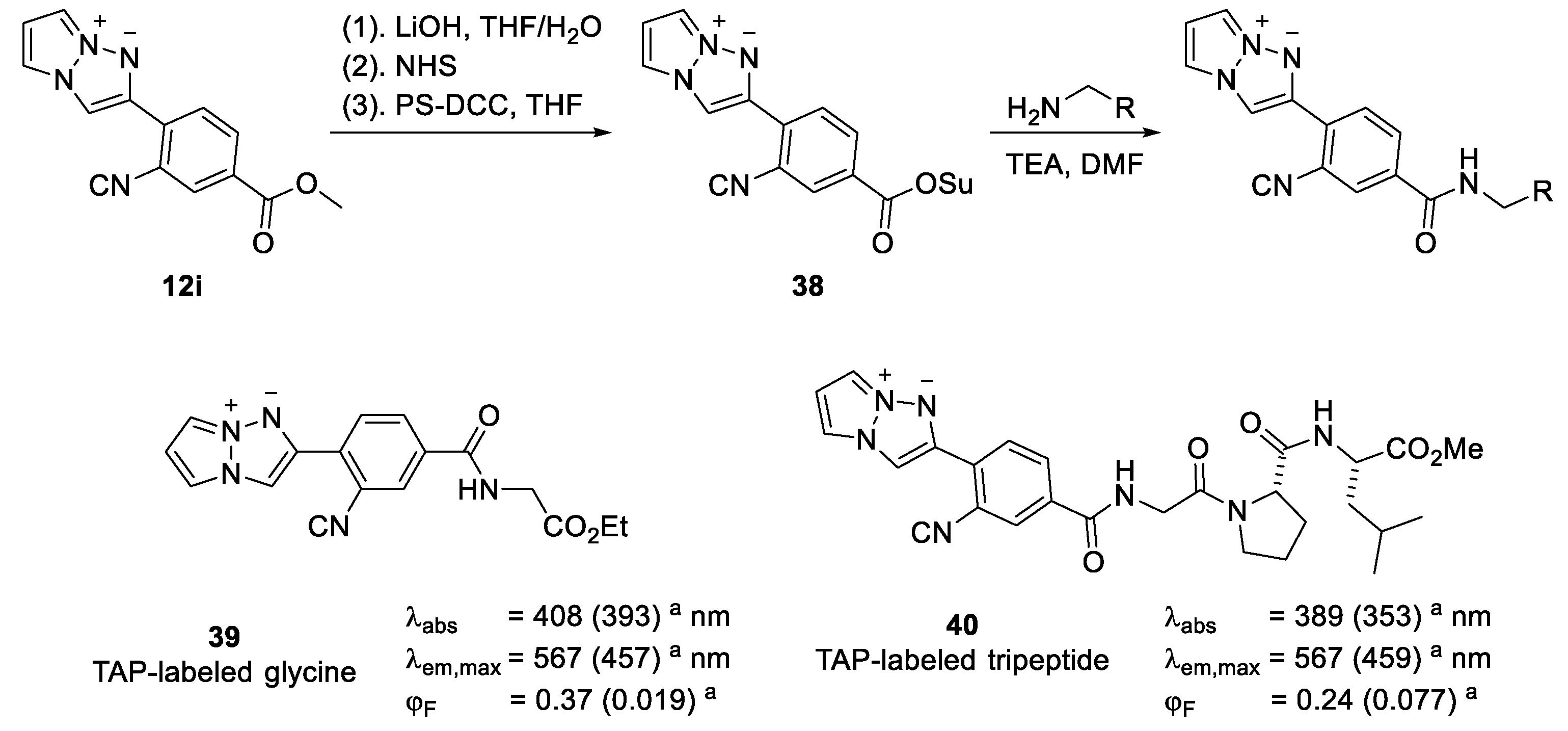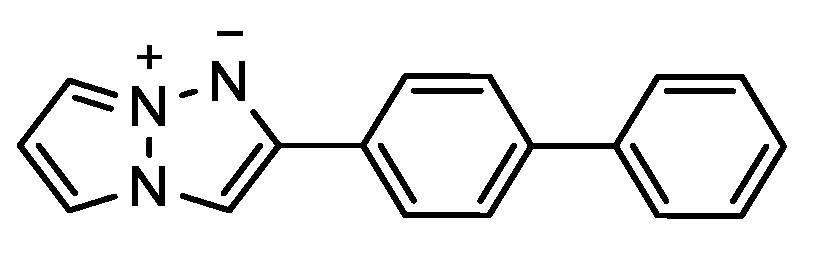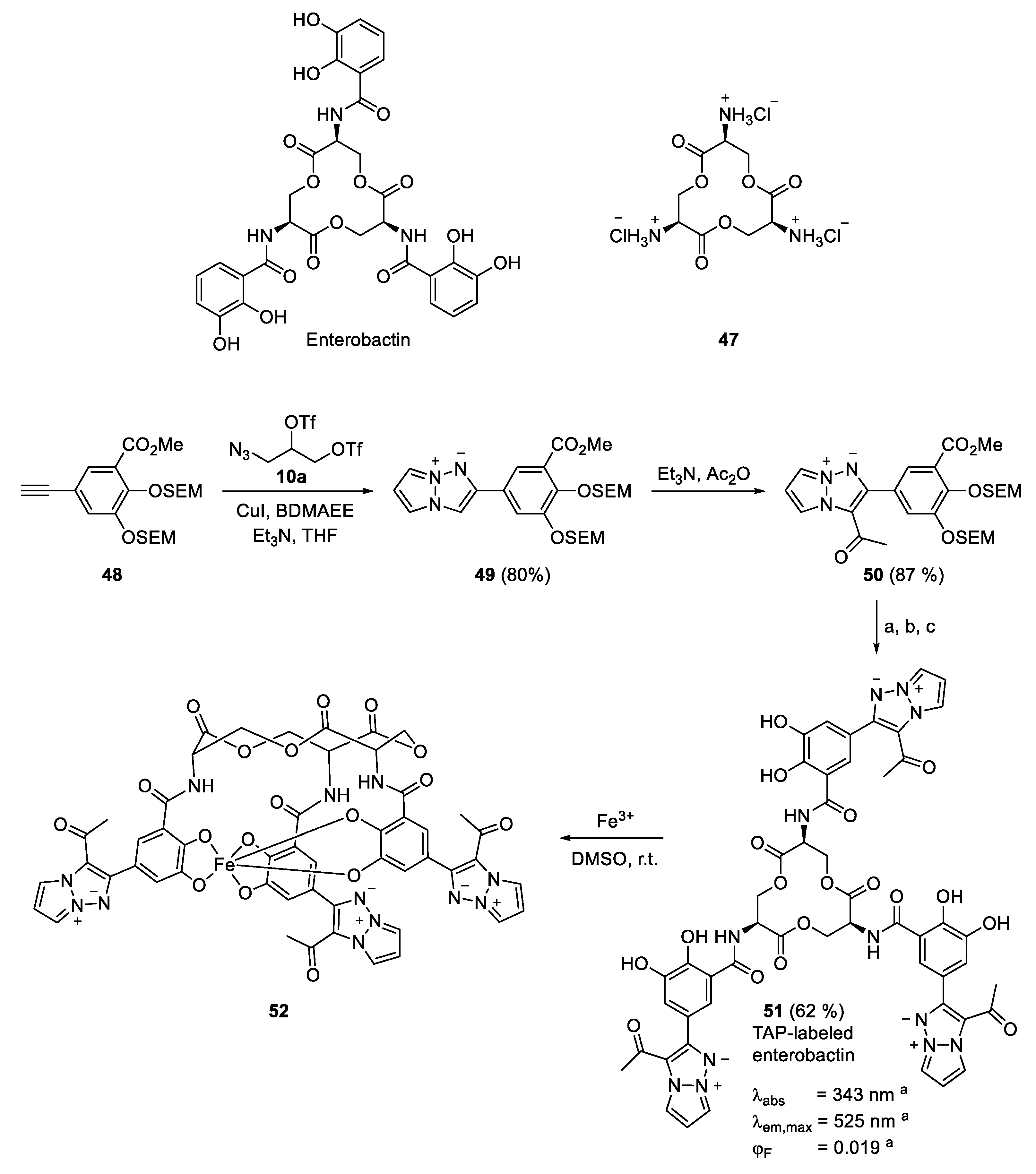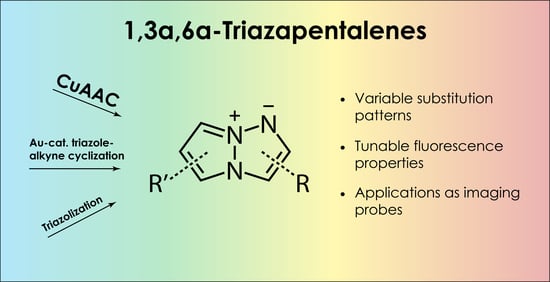1. Introduction
Organic fluorophores have been widely applied in modern science and technology as biological labels and probes [
1,
2,
3,
4,
5,
6], fluorescent sensors [
7,
8,
9,
10,
11], etc. Advances in these applications are often driven by the development of new fluorescent dyes, aiming to acquire the desired physicochemical and photophysical properties. Therefore, the design of novel organic dyes and studying synthetic pathways for their preparation are relevant research areas that have received ample attention in recent decades [
12,
13,
14,
15,
16]. However, most organic fluorophores are relatively large and hydrophobic, limiting their use in aqueous systems. In this regard, the 1,3a,6a-triazapentalene (TAP) sparked considerable interest upon its introduction a decade ago as a novel 10π-electron fluorophore due to its small size [
17,
18]. Generally, 1,3a,6a-triazapentalenes can be categorized into two types: (1) (hetero)aryl-fused and (2) the non-fused, simply bicyclic parent TAPs (
Figure 1).
The (hetero)aryl-fused TAPs were reported for the first time in 1965 [
19], and published methods to synthesize fused TAPs involve the deoxygenation of 1-(
o-nitro(hetero)aryl)pyrazoles and thermolysis or photolysis of 1-(
o-azido(hetero)aryl)pyrazoles [
18,
19,
20,
21,
22], among others [
23,
24]. In general, the fluorescence properties of these fused TAPs are much less described, and this is why we will not include them in this literature study. However, we should mention a recent (2020) synthetic method based on intramolecular
N-
N bond formation of pyrazole-substituted aminopyridines and aminodiazines in the presence of hypervalent iodine(III) leading to tricyclic TAP derivatives with fluorescent behavior, that was published by Suzenet et al. [
25]. This is a very interesting new development in TAP chemistry.
The bicyclic TAPs, which are the subject of this mini review, have been prepared via different synthetic pathways. Hirobe et al. were the first to report the bicyclic (non-fused) triazapentalenes in 1978 [
26]. However, during the decades that followed, this heterocyclic scaffold was somehow not further studied, until a reappearance was made in 2011 [
17]. Namba et al. cleverly applied the copper-catalyzed azide-alkyne cycloaddition (CuAAC) reaction for the synthesis of the parent TAPs, which resulted in a number of valuable studies published by this group throughout the past decade [
27,
28,
29,
30]. Furthermore, these findings also encouraged other researchers to study the TAP fluorophore and to develop alternative methods for their preparation [
31,
32].
In this mini review, we will cover the different synthetic methods toward bicyclic triazapentalenes, along with the photophysical data and applications of the respective dyes. Throughout the remaining part of this text, TAP will only refer to bicyclic, non-aryl-fused triazapentalenes.
4. Applications
The fluorescent TAP core has been studied by the Namba group as an element of biological imaging probes and sensors. All TAP products discussed within this section were synthesized via the CuAAC-based strategy.
The first application concerns the use of TAP as a fluorescent probe for live cell imaging [
28]. Compound
12i was selected as the fluorescent dye due to its small but significant solubility in water and because it combines a long fluorescent wavelength with acceptable stability under UV irradiation (
Scheme 12). After treatment with a DMSO solution of the fluorescent dye
12i, staining of Hela cells was clearly observed with fluorescence microscopy and no cytotoxic effect was seen during the observation period.
Then, the TAP
12i was developed as a fluorescent reagent to label glycine ethyl ester and tripeptide Gly-Pro-Leu [
28]. By treating methyl ester TAP
12i with lithium hydroxide, a benzoic acid derivative was obtained that was directly converted into an activated
N-hydroxysuccinimide (NHS) ester
38. As the purification from the DCC-derived urea was troublesome, instead, polymer-supported DCC was used and could be filtered off to give pure reactive ester
38. Subsequently, compound
38 was reacted with glycine ethyl ester and tripeptide Gly-Pro-Leu to obtain the labeled glycine
39 and tripeptide
40, respectively. Compounds
39 and
40 showed the same fluorescence maximum at 567 nm with 37% and 24% fluorescence quantum yields in DCM, respectively. The fluorescence measurements for these compounds in water demonstrated decreased Stokes shifts and quantum yields.
The second application was based on compound
12e (
Figure 2), which showed high fluorescence intensity in phosphate-buffered saline (PBS) and was applied as a fluorescent probe to observe cellular differentiation processes in various living cells [
38]. After treatment with a PBS solution of
12e, cytoplasmic and nuclear morphological changes during the differentiation processes were monitored by fluorescence microscopy. It was found that the fluorescence probe
12e had no toxicity, neither was there an effect on the cellular differentiation processes, and the probe could be easily washed away from the cells that can continue to culture for following studies.
In a third application, TAP analogs of biphenyl-type kinesin spindle protein (KSP) inhibitors
41 and
42 (
Figure 3) were prepared and investigated as bifunctional fluorescent probes [
39]. Both analogs showed inhibitory activity against KSP ATPase, although
42 was more potent (half maximal inhibitory concentration (IC
50) was 6.8 µM). Further microscopic studies were carried out with
42 in cultured cells in order to visualize the intracellular distribution. The partial colocalization of compound
42 with KSP, combined with its inhibitory activity, demonstrated the potency of the TAP fluorophore to be used as a probe for the visualization of bioactive substances and their targets.
Most recently, a compact vinyl ketone functionalized TAP
45 was cleverly designed by Namba et al. as a thiol-specific fluorescent labeling reagent [
40]. Starting from the previously reported 2-methoxycarbonyl-TAP
43, the electrophilic α,β-unsaturated ketone TAP
45 was prepared via a high-yielding multistep synthesis involving Weinreb amide
44 (
Scheme 13). The 2-vinyl ketone-TAP
45 was then reacted with various thiols via thiol Michael additions to obtain compounds
46. Remarkably, the fluorescence intensity of
45 was turned off due to the conjugation of the vinyl ketone at the C2 position. After the addition of the thiol group, this conjugation was interrupted, and the fluorescence of compound
46 was turned on again while also exhibiting shorter emission wavelengths as compared to
45. A water-soluble R8 peptide was also successfully labeled in a phosphate buffer (pH 7). Although no fluorescence was observed in water, the labeled peptide became luminescent after uptake and localization in the hydrophobic regions of A549 cells. Advantageously, the vinyl ketone TAP did not cause any background fluorescence and was not found to be cytotoxic. Next, a captopril-TAP conjugate was prepared for drug imaging. Captopril is a cysteine derivative that inhibits angiotensin converting enzyme (ACE) and has been used for the treatment of hypertensive patients. The inhibitory activity and confocal laser microscope imaging studies in vascular endothelial cells demonstrated that the fluorophore had no impact on the activity of captopril and that the fluorophore could be used as a probe for mechanistic studies.
In a final application, TAP derivative
51 was used as a fluorescent sensor for iron (
Scheme 14) [
41]. Starting with a protected catechol-containing alkyne
48 and azide
10a, TAP
49 was obtained via the CuAAC reaction strategy. In order to increase the stability, an acetyl group was introduced into compound
49 at the C3 position through acylation. The acetylated compound
50 was further conjugated to serine trimer
47 by saponification and amide coupling. After deprotection with HCl, the TAP labeled enterobactin
51 was obtained. The influence of iron on the fluorescent properties of sensor
51 was studied with Fe(acac)
3 as an Fe
3+ ion source at different concentrations. When increasing the amount of Fe
3+ in a DMSO solution of
51, the fluorescence intensity was decreased gradually, with complete disappearance at 1.2 equivalents of Fe(acac)
3. The emission maximum did not change. In DMF and
tert-butanol, a similar phenomenon was observed. Fourth-period metals also caused a clear decrease in fluorescence intensity, although no complete quenching was observed, even while adding 5.0 equivalents. Thus, 1,3a,6a-triazapentalene-labeled enterobactin
51 was shown to be a selective and highly sensitive fluorescence-quenching sensor for iron (III).
5. Conclusions
In this mini review, we have discussed the different synthetic methodologies of bicyclic 1,3a,6a-triazapentalenes. An alternative to the earlier synthesis from pyrazoles and aminating reagents was provided by the CuAAC-based strategy, which could be used to synthesize a wide scope of 2-substituted TAPs. The gold-catalyzed cyclization pathway afforded excellent yields of highly functionalized TAPs with electron withdrawing functional groups at the C3 position. Unfortunately, the starting materials for these methods often need to be prepared via a multistep synthesis. The triazolization-mediated synthesis provided access to 2-unsubstituted TAPs from readily available starting materials. Therefore, this was complementary to the previous strategies.
As a result of the profound studies by Namba et al., the substituent effects on the properties of TAP are known and could allow one to design the fluorophores according to the requirements of a particular application. For example, the stability of the TAP core could at first be ensured by introducing an electron withdrawing group at the C3 position, while the fluorescence wavelength could be adjusted by variation of the substituent at the C2 position. Further adjustments of the properties could be made with the substituent at the C4, C5 or C6 position. For instance, the extinction coefficient and therefore brightness of TAPs could be increased by introducing a substituent at the C4 position. For the TAP compounds that require high quantum yields, often it is a good idea to introduce a substituent at the C5 or C6 position.
Applications of TAPs were mainly focused on live-cell fluorescence imaging, in particular drug imaging, although an application as iron chemosensor was also reported. The small size of the TAP core is often mentioned as an advantage compared to other fluorescent probes. Up to this moment, reports about TAP probes and sensors have been limited to 2-substituted TAPs, which are obtained via the CuAAC method. Problems that often occur and still need to be solved are poor solubility and weak fluorescence intensity of the TAP probes in water.
We are only at the start of the applications of this new and compact fluorophore TAP. Hopefully, this review will stimulate further investigations.



